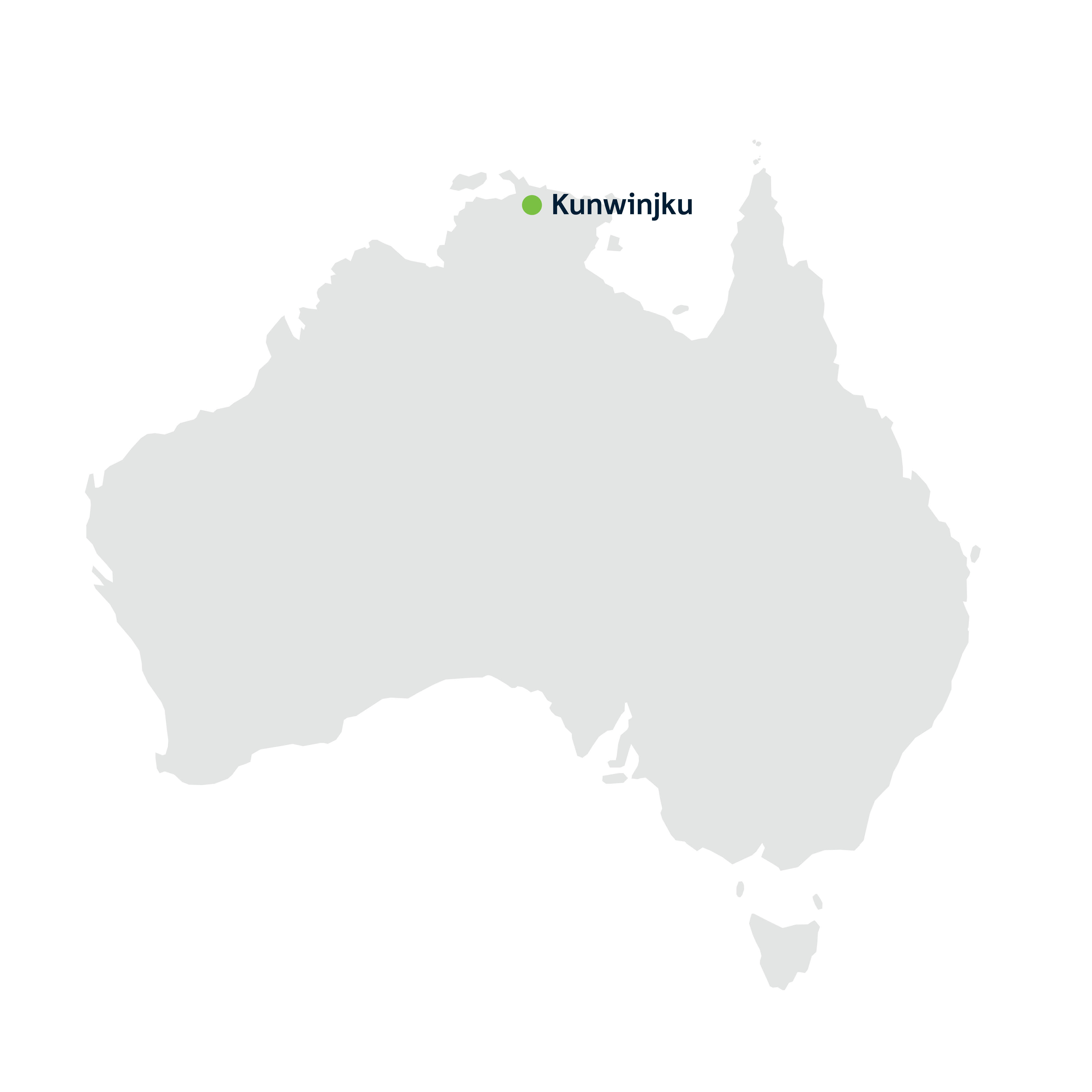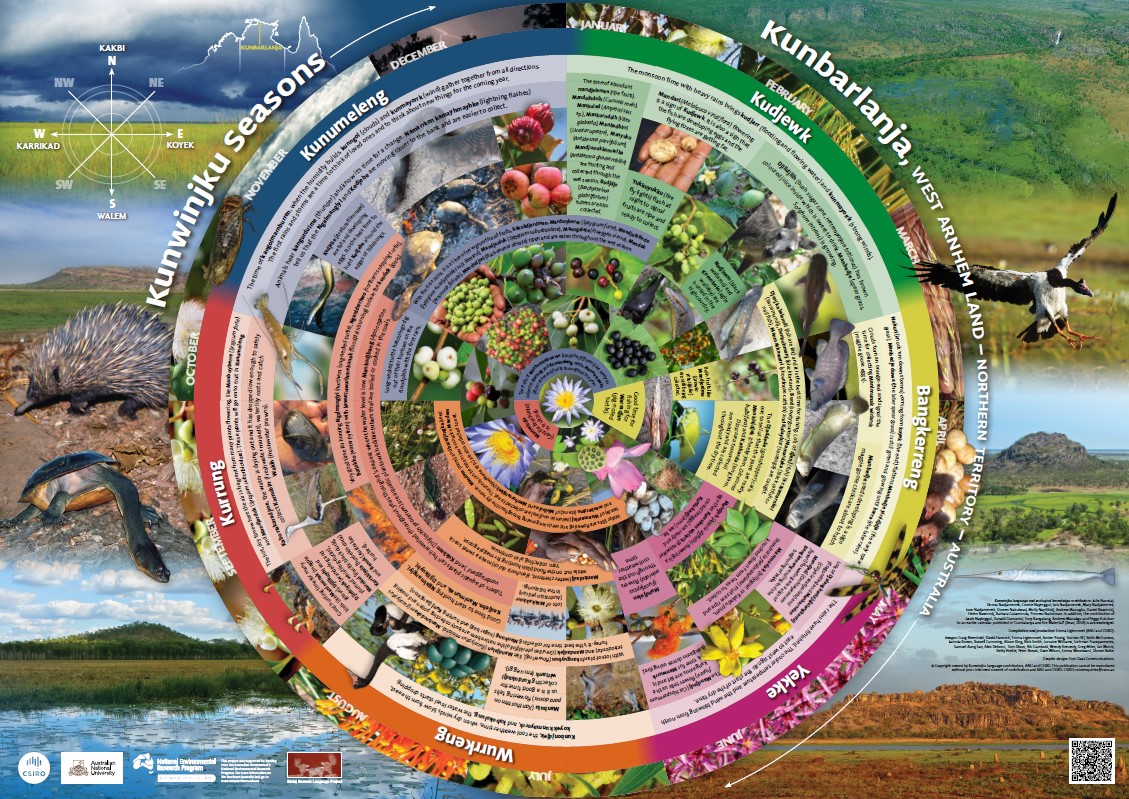 CSIRO worked in collaboration with Traditional Owners from Kunbarlanja (Gunbalanya) in western Arnhem Land in the Northern Territory to document Kunwinjku knowledge of the seasons and the environment in a calendar. 1
CSIRO worked in collaboration with Traditional Owners from Kunbarlanja (Gunbalanya) in western Arnhem Land in the Northern Territory to document Kunwinjku knowledge of the seasons and the environment in a calendar. 1
The development of the calendar, which is part of the National Environmental Research Program, came from a desire to record Indigenous ecological knowledge in a way that helped students learn ‘both ways’.
For senior Kunbarlanja Traditional Owner, Julie Narndal, the seasonal calendar is a valuable cultural learning aid to help share Aboriginal knowledge with the next generation, while also providing relevant entry points for students into the science curriculum.
‘We want to share our knowledge with the kids and help them learn at school,’ she said.
The calendar was developed as part of a CSIRO and Australian National University PhD project on freshwater customary harvesting practices and climate change adaptation. It was supported by the National Environmental Research Program and the Bininj Gunwok Language Project.
Kunwinjku seasons calendar

Kunwinjku seasons
Kudjewk
The monsoon time with heavy rains brings kudjarr (flooding and flowing water) and kunmayorrk (strong winds). It’s a time of abundant fruits with the Yukkuyyukku (fire fly lights) flashing at night to signal the bush fruits are ready to collect.
Bangkerreng
Nakurl (knock ’em down storms) coming from koyek (the east) flattens Manbedje yirridjdja (the early spear grass). Manbedje duwa (the later spear grass) is still green and growing until barra (the later rains). It is the time for collecting magpie goose eggs, Manimunak wirlarrk and a good time for fishing.
Yekke
The rains have finished. The cooler temperature and the wind blowing from north east to west signals the start of the dry time. Lots of Djalangkarridjdjalangkarridj (dragonflies) and Manbarndarr (Calytrix exstipulata) and Mandjedj (Cochlospermum fraseri) flowering are a sign of Yekke.
Wurrkeng
Kunbonjdjek- the cool weather time, when dry winds blow from the east, koyek kunmayorrk. Many plants are flowering, like Mandjalen (Eucalyptus miniata), Manbordokorr (Eucalyptus tetrodonta) and Mandadjek (Grevillea pteridifolia) and the native bees are busy so it’s a good time to collect Mankung, sugar bag.
Kurrung
The hot, dry time where the air is fragrant from many plants flowering, like Manboyberre (Syzgium forte) and Mandjarduk (Syzgium suborbiculare). It’s a very good time for hunting waterbirds like Manimunak (magpie goose), Ngalmangiyi (northern long-necked turtle) with kawurluwurlhme kunak (floodplain burning) to clear the kundalk (grass) as well as hunt Kedjebe (Arafura filesnake) around the edge of billabongs.
Kunumeleng
The time of kangolmarnburren, when the humidity builds, kunngol (clouds) and kunmayorrk (wind) gather together from all directions. Animals hear kangurdulme (thunder) and know it’s time for a change. Namarrkon kamayhmayhke (lightning flashes) tell us that the Ngalmangiyi and Kedjebe are moving closer to the bank and are easier to collect.
Citation
- Julie Narndal, Donna Nadjamerrek, Connie Nayinggul, Lois Nadjamerrek, Mary Nadjamerrek, June Nadjamerrek, Doreen Nabulwad, Molly Nayilibidj, Andrew Managku, Daniel Nawirridj, Helen Nawirridj, Barbara Galamirnda, Princess Narloman and Emma Ligtermoet (2015) Kunwinjku Seasons, Kunbarlanja (Gunbalanya), Northern Territory, Australia. CSIRO Land and Water.
CSIRO worked in collaboration with Traditional Owners from Kunbarlanja (Gunbalanya) in western Arnhem Land in the Northern Territory to document Kunwinjku knowledge of the seasons and the environment in a calendar. 1
The development of the calendar, which is part of the National Environmental Research Program, came from a desire to record Indigenous ecological knowledge in a way that helped students learn ‘both ways’.
For senior Kunbarlanja Traditional Owner, Julie Narndal, the seasonal calendar is a valuable cultural learning aid to help share Aboriginal knowledge with the next generation, while also providing relevant entry points for students into the science curriculum.
‘We want to share our knowledge with the kids and help them learn at school,’ she said.
The calendar was developed as part of a CSIRO and Australian National University PhD project on freshwater customary harvesting practices and climate change adaptation. It was supported by the National Environmental Research Program and the Bininj Gunwok Language Project.
Kunwinjku seasons calendar
Kunwinjku seasons
Kudjewk
The monsoon time with heavy rains brings kudjarr (flooding and flowing water) and kunmayorrk (strong winds). It’s a time of abundant fruits with the Yukkuyyukku (fire fly lights) flashing at night to signal the bush fruits are ready to collect.
Bangkerreng
Nakurl (knock ’em down storms) coming from koyek (the east) flattens Manbedje yirridjdja (the early spear grass). Manbedje duwa (the later spear grass) is still green and growing until barra (the later rains). It is the time for collecting magpie goose eggs, Manimunak wirlarrk and a good time for fishing.
Yekke
The rains have finished. The cooler temperature and the wind blowing from north east to west signals the start of the dry time. Lots of Djalangkarridjdjalangkarridj (dragonflies) and Manbarndarr (Calytrix exstipulata) and Mandjedj (Cochlospermum fraseri) flowering are a sign of Yekke.
Wurrkeng
Kunbonjdjek- the cool weather time, when dry winds blow from the east, koyek kunmayorrk. Many plants are flowering, like Mandjalen (Eucalyptus miniata), Manbordokorr (Eucalyptus tetrodonta) and Mandadjek (Grevillea pteridifolia) and the native bees are busy so it’s a good time to collect Mankung, sugar bag.
Kurrung
The hot, dry time where the air is fragrant from many plants flowering, like Manboyberre (Syzgium forte) and Mandjarduk (Syzgium suborbiculare). It’s a very good time for hunting waterbirds like Manimunak (magpie goose), Ngalmangiyi (northern long-necked turtle) with kawurluwurlhme kunak (floodplain burning) to clear the kundalk (grass) as well as hunt Kedjebe (Arafura filesnake) around the edge of billabongs.
Kunumeleng
The time of kangolmarnburren, when the humidity builds, kunngol (clouds) and kunmayorrk (wind) gather together from all directions. Animals hear kangurdulme (thunder) and know it’s time for a change. Namarrkon kamayhmayhke (lightning flashes) tell us that the Ngalmangiyi and Kedjebe are moving closer to the bank and are easier to collect.
Citation
- Julie Narndal, Donna Nadjamerrek, Connie Nayinggul, Lois Nadjamerrek, Mary Nadjamerrek, June Nadjamerrek, Doreen Nabulwad, Molly Nayilibidj, Andrew Managku, Daniel Nawirridj, Helen Nawirridj, Barbara Galamirnda, Princess Narloman and Emma Ligtermoet (2015) Kunwinjku Seasons, Kunbarlanja (Gunbalanya), Northern Territory, Australia. CSIRO Land and Water.
